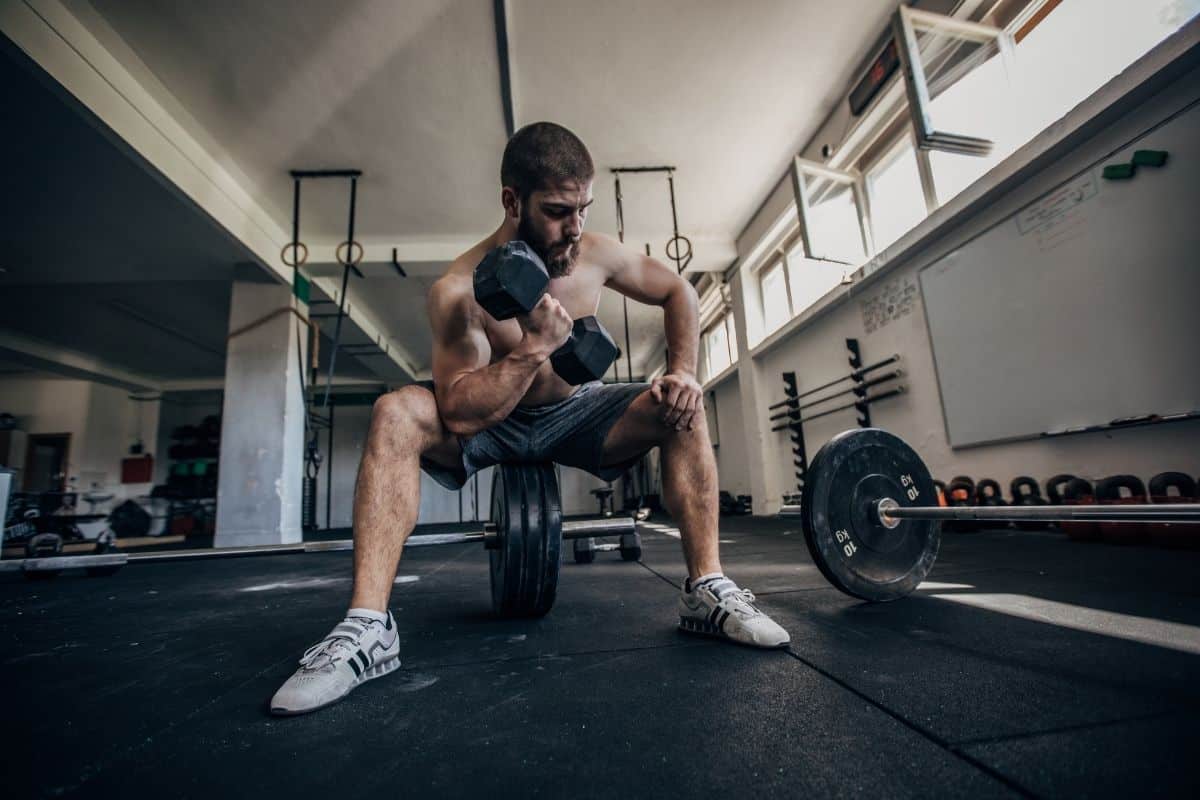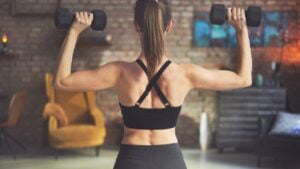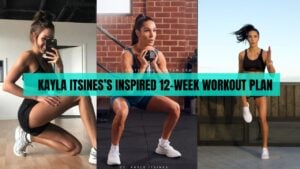If you design the dumbbell push/pull/legs (PPL) workout program, you need a proper guide on PPL exercises. Having a list of the entire workouts, you’ll be able to design an effective workout program. I’ve already shared dumbbell push and leg exercises, and here I’ll hand out the best dumbbell pull exercises to do on your push day.
In this article, you’ll see a list of dumbbell pull workouts, how to do them step-by-step, what muscles they target, and pull day dumbbell workout routines.
This guide is for everyone. Whether you’re a male or female, beginner or intermediate, you can use all exercises to build muscles and improve your physique.
Dumbbell Pull Workout Muscles Worked
The dumbbell pull exercises work on multiple muscle groups, particularly the back, biceps, posterior deltoid, and forearms. So let’s take a look at each of them.
1. Back
The back is the largest muscle of the upper body. It is a group of four muscles: the latissimus dorsi, trapezius, infraspinatus, and erector spinae. The different dumbbell rowing exercises help strengthen all these muscles and build a defined back.
2. Biceps
The biceps are the second most engaged muscle during the dumbbell pull workout. It is made of two muscles, the long and short heads, and to build bigger biceps, you’ll need to hit them both. Fortunately, the different variations of dumbbell pulling exercises, particularly the curls, sculpt your biceps and help build muscular arms.
3. Posterior Delt
The posterior deltoid is the rear portion of the shoulder muscles that work during the various dumbbell pull workouts, such as dumbbell face-pull, incline row, and seal row. Having a sturdy and sizeable rear delt adds definition to your entire back.
20 Best Dumbbell Pull Exercises to Build Muscle
Below, I’ve made a list of exercises you can do on your pull day.
- Dumbbell Bent-over Row
- One-arm Dumbbell Row
- Dumbbell Seal Row
- Incline Chest Supported Row
- Dumbbell Deadlift
- Dumbbell Superman Pull
- Incline Plank Rowing
- Dumbbell Upright Row
- Dumbbell Pullover
- Dumbbell Face Pull
- Dumbbell High Pull
- Renegade Row
- Dumbbell Shrugs
- Dumbbell Bicep Curl
- Incline Dumbbell Curl
- Dumbbell Hammer Curl
- Concentration Curl
- Dumbbell Prone Lying Curl
- Dumbbell Zottman Curl
- Dumbbell Drag Curl
Let’s see how to do each exercise step-by-step.
1. Dumbbell Bent-over Row
| Muscle Worked | Equipment Needed | Level |
|---|---|---|
| Back | Dumbbells Only | Beginner |
The bent-over row is an excellent dumbbell pull workout that helps forge back muscles. It focuses on the entire back, from the traps down to the lower back.1 Fenwick, C. M., Brown, S. H., & McGill, S. M. (2009). Comparison of different rowing exercises: trunk muscle activation and lumbar spine motion, load, and stiffness. Journal of strength and conditioning research, 23(2), 350–358. https://doi.org/10.1519/JSC.0b013e3181942019, 2American Council of Exercise (ACE) RESEARCH: What Is the Best Back Exercise? by Holly Edelburg, B.S., John P. Porcari, Ph.D., Clayton Camic, Ph.D., Attila Kovacs, Ph.D., and Carl Foster, Ph.D., with Daniel J. Green
How to do it:
- Grab a pair of dumbbells with an overhand grip and stand straight with your feet shoulder-width apart.
- Hinge forward at your hips with a slight bend in your knees.
- Row the dumbbells at your sides by pulling your elbows back until your back muscles are fully contracted. Shoot for three to four sets of eight to 12 reps.
2. One-arm Dumbbell Row

| Muscle Worked | Equipment Needed | Level |
|---|---|---|
| Back | Dumbbells and Bench | Beginner |
Unlike the machines, this exercise allows you to perform rowing with a full range of motion. The single-arm row hits the lats and traps as well as engages the abdominal muscles.3 Saeterbakken, A., Andersen, V., Brudeseth, A., Lund, H., & Fimland, M. S. (2015). The Effect of Performing Bi- and Unilateral Row Exercises on Core Muscle Activation. International journal of sports medicine, 36(11), 900–905. https://doi.org/10.1055/s-0034-1398646, 4Graham, John F. BS, CSCS, D*. Dumbbell One-Arm Row. Strength and Conditioning Journal 23(2):p 59, April 2001.
If you want to train each side unilaterally while improving balance and posture, include this exercise in your program.5 Dumbbell Row: Muscles Worked, Proper Form, Variations & More – International Sports Sciences Association (ISSA)
The single-arm row involves the following steps:
- Holding a dumbbell in your right hand, place your left knee and hand on the bench.
- Maintain a flat back and keep your right arm straight below your shoulder.
- Bringing your elbows back, pull the weight until your lats are contracted.
- Pause for a moment and return to the start. Go for the recommended sets and reps.
3. Dumbbell Seal Row
| Muscle Worked | Equipment Needed | Level |
|---|---|---|
| Back and Rear Delt | Dumbbells, Box, and Bench | Intermediate |
If you are looking for a way to strengthen your upper back, the seal row may be a great move for you. Dumbbell seal rows build a strong upper back, targeting mid lats, traps, and rhomboids.
It involves lying prone on the bench, providing support, and ensuring that no stress is placed on the lower back. Plus, it also allows you to hit your back with strict form.
To do a dumbbell seal row:
- Place the foot of the bench on elevated objects, and holding one dumbbell in each hand, lie on it with your arms straight down and palms facing each other. That’s the start.
- Row the dumbbells at your sides until you feel the work in your back muscles.
- Aim for three sets of eight to ten reps.
4. Incline Chest Supported Row

| Muscle Worked | Equipment Needed | Level |
|---|---|---|
| Back and Shoulders | Dumbbells and Bench | Beginner |
The chest-supported row is an isolation exercise that allows you to train your back muscles without placing stress on the lower back. It is an excellent alternative to the bent-over row for individuals who struggle to achieve a proper bent-over stance.
It also engages the medial and rear delts and helps achieve a muscular upper body appearance.6 Exclusive ACE-sponsored Research: Shoulders above the rest? By Samantha Sweeney, M.S., John P. Porcari, Ph.D., Clayton Camic, Ph.D., Attila Kovacs, Ph.D., and Carl Foster, Ph. D. – American Council of Exercise
To perform an inclined row:
- Holding one dumbbell in each hand, lie prone on a 45-degree incline bench with your arms straight beneath your shoulders.
- Pulling your elbows back, row the dumbbells at your sides until you feel the good work in your back muscles.
You can perform incline rowing in two ways, using the neutral and underhand grip. The neutral grip focuses more on your back muscles, while the underhand grip works more on your rear delt and upper trap.
5. Dumbbell Deadlift
| Muscle Worked | Equipment Needed | Level |
|---|---|---|
| Posterior Chain | Dumbbells Only | Intermediate |
The dumbbell deadlift is a full-body pull exercise that strengthens multiple muscles simultaneously, including the back, hamstrings, glutes, and quadriceps.7 Martín-Fuentes I, Oliva-Lozano JM, Muyor JM. Electromyographic activity in deadlift exercise and its variants. A systematic review. PLoS One. 2020 Feb 27;15(2):e0229507. doi: 10.1371/journal.pone.0229507. PMID: 32107499; PMCID: PMC7046193.
Heavy deadlifts build strength and increase muscle growth, helping you achieve a muscular physique.
How to perform the dumbbell deadlift:
- Holding one dumbbell in each hand, stand upright with feet hip to shoulder-width apart.
- Keep your arms straight with your palms facing your thigh.
- Bend your hips and knees, lower down until your glutes are below your hips and above your knees.
- Now, pushing through your feet, return to the standing position until your hips are forward. That’s one rep!
- Shoot for three to four sets of four to eight repetitions.
6. Dumbbell Superman Pull
| Muscle Worked | Equipment Needed | Level |
|---|---|---|
| Posterior Chain | Dumbbells Only | Intermediate |
The dumbbell superman row is a pull exercise. It involves lying on the floor face down and driving your elbows inward. This position strengthens multiple muscles at once, including the lats, traps, lower back, and shoulders.8 Hwang YI, Park DJ. Comparison of lumbar multifidus thickness and perceived exertion during graded superman exercises with or without an abdominal drawing-in maneuver in young adults. J Exerc Rehabil. 2018 Aug 24;14(4):628-632. doi: 10.12965/jer.1836296.148. PMID: 30276184; PMCID: PMC6165989.
Steps to perform the Superman row:
- Holding a pair of dumbbells, lie on the floor with your arms straight in front of you and palms facing down.
- Lift your chest slightly off the floor and pull the dumbbells in as close to your chest as possible.
- Pause for a moment and bring your arms to the start.
7. Incline Plank Rowing
| Muscle Worked | Equipment Needed | Level |
|---|---|---|
| Back and Core | Dumbbells and Bench | Intermediate |
The elevated plank row is another great exercise for building strength, endurance, and stability. It involves getting into a 45-60 angle and rowing with one arm at a time. This exercise targets the lats, traps, and abdominals and builds a strong and athletic torso.
The incline plank row involves the following steps:
- Place your right hand on a flat bench and extend your legs back to get into the plank position.
- Grab a dumbbell in your left hand and hold your arm straight beneath your shoulder.
- Now, pull the dumbbell in a rowing motion until you feel the work in your back muscles.
- Your core should be tight and your back straight during the entire exercise.
8. Dumbbell Upright Row

| Muscle Worked | Equipment Needed | Level |
|---|---|---|
| Shoulder and Back | Dumbbells Only | Beginner |
The upright row is an excellent exercise for strengthening the shoulder and upper trap muscles. You can do this pull workout with dumbbells, barbells, and cables, depending on what you have. All variations are excellent and help you improve your upper body musculature.
Whichever equipment you use, ensure you maintain a hip-width distance between your hands to stimulate traps and delts effectively and avoid letting your elbows go beyond your shoulder level to prevent subacromial injuries.9 McAllister, M. J., Schilling, B. K., Hammond, K. G., Weiss, L. W., & Farney, T. M. (2013). Effect of grip width on electromyographic activity during the upright row. Journal of strength and conditioning research, 27(1), 181–187. https://doi.org/10.1519/JSC.0b013e31824f23ad, 10Schoenfeld, Brad & Kolber, Morey & Haimes, Jonathan. (2011). The Upright Row: Implications for Preventing Subacromial Impingement. Strength & Conditioning Journal. 33. 25-28. 10.1519/SSC.0b013e31822ec3e3.
Steps to perform the upright row with dumbbells:
- Grab a pair of dumbbells and stand upright.
- Keep your arms straight against your things with your palms facing in.
- Row the dumbbells toward your neck.
- Pause and then return to the start.
9. Dumbbell Pullover

| Muscle Worked | Equipment Needed | Level |
|---|---|---|
| Chest and Lats | Dumbbells and Bench | Intermediate |
The dumbbell pullover is an upper-body muscle-building exercise. It targets the pectorals and latissimus dorsi simultaneously and helps build strength and muscle.11 Effects of the Pullover Exercise on the Pectoralis Major and Latissimus Dorsi Muscles as Evaluated by EMG – Journal of Applied Biomechanics
Many bodybuilders perform this exercise as a finisher on their chest day, but you can also perform it on your pull day.
The dumbbell pullover can be done in several ways, such as on an inclined or declined bench, but the standard one is the most effective.
Follow these instructions to perform the flat dumbbell pullover:
- Holding a dumbbell with your hands, lie on a flat bench with your feet on the ground.
- Keep your head at the end of the bench, and extend your arms behind your head (with your elbows straight). That’s the starting position.
- Slightly lift your lower back off the bench, inhale, and pull the dumbbell over you until it comes directly over your chest.
- At the top, Squeeze your chest and then return the dumbbell to the start.
10. Dumbbell Face Pull
| Muscle Worked | Equipment Needed | Level |
|---|---|---|
| Traps and Rear Delt | Dumbbells Only | Intermediate |
The dumbbell face pull can be used as an alternative to the cable face pull, as it also isolates the upper back and rear deltoid effectively.
For better stability, place your forehead on a bench (in a bent-over position) and maintain a straight back.
Steps to perform Dumbbell Face Pull:
- Grab one dumbbell in each hand and hinge forward by bending your hips and knees until your torso is parallel to the floor, and keep your arms straight downward.
- Now, pull the dumbbells toward you in a rowing motion until they are aligned with your ears.
11. Sumo Deadlift High Pull
| Muscle Worked | Equipment Needed | Level |
|---|---|---|
| Total Body | Dumbbells Only | Intermediate |
The Sumo deadlift to high pull is a full-body exercise, engaging multiple muscles throughout the body, including glutes, hamstrings, quads, lower back, traps, rhomboids, and deltoids.
It involves lifting weights at a faster pace, helping you train fast-twitch muscle fibers and build power and endurance.
It is for advanced lifters, not for beginners. Doing Sumo Deadlift and high pull individually can also work well for anyone.
To perform the DB Sumo deadlift high pull:
- Pick one dumbbell in each hand and stand upright, keeping your arms straight against your thighs and palms facing in.
- Perform a sumo deadlift and then pull the dumbbell toward your neck. Ensure your spine is in a neutral position throughout the exercise.
- Perform each rep in a controlled fashion.
12. Renegade Row

| Muscle Worked | Equipment Needed | Level |
|---|---|---|
| Back and Abs | Dumbbells Only | Intermediate |
If you want to enhance your strength and mobility using a pair of dumbbells, consider doing the renegade row.
The renegade row is an advanced dumbbell pull exercise that involves rowing the dumbbell alternately. When you row, you have to balance your weight on one arm.
Rowing trains the lats and traps, and staying on one arm improves balance and abdominal strength.
To do a renegade row:
- Grab one dumbbell in each hand with a neutral grip and get into a high plank position with your arms straight underneath your shoulders.
- Row the dumbbell at your side one by one for the recommended times.
13. Dumbbell Shrugs

| Muscle Worked | Equipment Needed | Level |
|---|---|---|
| Shoulder & Traps | Dumbbells Only | Beginner |
The shrug is a pull workout that primarily strengthens the shoulder and upper traps, improves upper body appearance, and posture.12 Lee, J. H., Cynn, H. S., Choi, W. J., Jeong, H. J., & Yoon, T. L. (2016). Various shrug exercises can change scapular kinematics and scapular rotator muscle activities in subjects with scapular downward rotation syndrome. Human movement science, 45, 119–129. https://doi.org/10.1016/j.humov.2015.11.016
To perform the shoulder shrug:
- Grab a pair of dumbbells with a neutral grip and stand with your torso slightly leaning forward. Maintain a straight back.
- Keep the dumbbells beside your thighs and brace your core.
- Pull your shoulder blades toward your ears until your upper traps are entirely engaged.
- Hold for a second at the top, rotate your shoulder girdle to return to the start.13 Pizzari, T., Wickham, J., Balster, S., Ganderton, C., & Watson, L. (2014). Modifying a shrug exercise can facilitate the upward rotator muscles of the scapula. Clinical biomechanics (Bristol, Avon), 29(2), 201–205. https://doi.org/10.1016/j.clinbiomech.2013.11.011
14. Alternating Dumbbell Bicep Curl
| Muscle Worked | Equipment Needed | Level |
|---|---|---|
| Biceps | Dumbbells Only | Beginner |
The alternate bicep curl is an isolation exercise. It involves curling one dumbbell at a time, alternating arms, and helps you build round and defined biceps.
Instructions to perform alternating biceps curl:
- Grab one dumbbell in each hand and sit on the bench with your feet flat on the floor and arms straight at your sides. You can also do it in a standing position.
- Curl your arm alternatively until your biceps are fully contracted.
- Perform ten reps on each side with moderate to heavy dumbbells.
15. Incline Dumbbell Curl
| Muscle Worked | Equipment Needed | Level |
|---|---|---|
| Biceps | Dumbbells and Bench | Intermediate |
The incline dumbbell curl involves lying on a 45-60 degree incline bench with arms straight downward. It provides decent maximum stretch and reduces momentum, so you can hammer your biceps effectively than other exercises.
A study has also suggested that the incline dumbbell curl is a preferable exercise to include in bicep training for achieving good results.14 Oliveira LF, Matta TT, Alves DS, Garcia MA, Vieira TM. Effect of the shoulder position on the biceps brachii EMG in different dumbbell curls. J Sports Sci Med. 2009 Mar 1;8(1):24-9. PMID: 24150552; PMCID: PMC3737788.
Follow the steps to perform the Incline DB Curl:
- Holding a pair of dumbbells with an underhand grip, lie on a 45 to 60-degree incline bench with your face up. Keep your arms straight at your sides.
- Curl your arms until your biceps are entirely contracted.
- Hold for a second, then slowly return to the start.
- That’s one rep. Perform two to four sets of 10-12 reps.
16. Dumbbell Hammer Curl

| Muscle Worked | Equipment Needed | Level |
|---|---|---|
| Biceps | Dumbbells only | Beginner |
The dumbbell hammer curls train more muscles than other biceps exercises. It focuses on the biceps brachii, brachialis, and the forearm simultaneously. Training biceps with different grip positions will help you achieve well-balanced arms.15 Coratella, G., Tornatore, G., Longo, S., Toninelli, N., Padovan, R., Esposito, F., & Cè, E. (2023). Biceps Brachii and Brachioradialis Excitation in Biceps Curl Exercise: Different Handgrips, Different Synergy. Sports (Basel, Switzerland), 11(3), 64. https://doi.org/10.3390/sports11030064
Steps to perform hammer curls:
- Grab a pair of dumbbells with a neutral grip and stand upright.
- Curl your arms until your biceps are fully contracted and palms face each other.
- Feel the squeeze in your biceps for a second, then return to the start.
You can do hammer curls on the preacher bench as well as using one arm at a time.
17. Concentration Curl

| Muscle Worked | Equipment Needed | Level |
|---|---|---|
| Biceps | Dumbbells and Bench | Beginner |
The concentration curls involve sitting on the bench and keeping the arm braced against the thigh. This position eliminates momentum, ensuring the biceps (especially the short head) do the work. It is great for developing the inner biceps and getting a round shape.16 ACE Study Reveals Best Biceps Exercises – American Council of Exercise
Steps to perform Concentration Curl:
- Sit on the edge of a flat bench or a Swiss ball.
- Pick a dumbbell in your right hand and place the back of your arm inside your right thigh.
- Slightly lean forward and do as many curls as you like.
- Repeat an equal number of sets and reps on each side.
18. Dumbbell Zottman Curl
| Muscle Worked | Equipment Needed | Level |
|---|---|---|
| Arms | Dumbbells Only | Intermediate |
The Zottman curls are a compound exercise for the arms. They hit the biceps brachii during the concentric phase and shift to the brachialis and forearms during the eccentric phase, offering a two-in-one exercise that builds arm size and grip strength more effectively than standard curls.17 Melrose, Don PhD, CSCS*D. Exercise Technique: The Zottman Curl. Strength and Conditioning Journal 36(1):p 92-93, February 2014. | DOI: 10.1519/SSC.0b013e318297a092
How to perform Zottman Curl:
- Grab one dumbbell in each hand and keep your arms straight with your palms facing your thighs.
- Twist your wrist as you curl your arm toward your front delt until your palms face your shoulder.
- Again, twist your wrist so your palms are facing forward, and return to the start.
19. Dumbbell Incline Prone Curl
| Muscle Worked | Equipment Needed | Level |
|---|---|---|
| Biceps | Dumbbells and Bench | Intermediate |
The inclined prone curl, also known as the Spider curl, is an excellent exercise for developing rounded biceps. The prone position ensures a deep stretch and full range of motion, allowing you to maintain constant tension for hypertrophy. Give it a try and see how it works differently from other bicep exercises.
How to perform prone inclined curls:
- Holding a pair of dumbbells, lie prone on a 45-degree incline bench and keep your arms straight downward.
- Curl your arms until your biceps are entirely engaged.
- Uncurl your arms and repeat for the recommended number of sets and reps.
20. Dumbbell Drag Curl
| Muscle Worked | Equipment Needed | Level |
|---|---|---|
| Biceps and Back | Dumbbells only | Intermediate |
The dumbbell drag curl involves dragging your elbows back as you curl your biceps. It trains the biceps from a different angle and helps increase strength and size.
Steps to Perform Dumbbell Drag Curls:
- Pick one dumbbell in each hand with an underhand grip.
- Next, curl your arms by driving your elbows backward until you feel the full contraction in your biceps.
- Pause for a moment, then uncurl your arms and repeat the suggested reps and sets.
30-Minute Pull Day Dumbbell Workout Routine
It’s essential to select the right exercises when creating a workout plan. A workout program should include a variety of exercises that target different muscles and deliver maximum results.
I’ve created a complete dumbbell PPL workout, which you can download or do the following exercises on your pull day.
Dumbbell Pull Workout A
| Exercise | Sets | Reps | Rest | Target Muscle |
|---|---|---|---|---|
| Deadlift | 4 | 10-12 | 1-2 min | Legs & Back |
| Bent-over Row | 4 | 12-15 | 1-2 min | Back |
| One-arm Dumbbell Row | 3 | 10/side | 1-minute | Back |
| Face Pull/Rear Delt Fly | 3 | 10-12 | 1-2 min | Shoulder & Trap |
| Incline Curl/Alternating Curl | 3 | 10-12 | 1-2 min | Biceps |
| Concentration Curl | 3 | 10/arm | 1-2 min | Biceps |
| Hammer Curl | 3 | 10-12 | 1-2 min | Biceps |
Pull Dumbbell Workout B
| Exercise | Sets | Reps | Rest | Target Muscle |
|---|---|---|---|---|
| Bent-over Row | 3 | 10-12 | 1-2 min | Back |
| Pullover | 3 | 10-12 | 1-2 min | Lats & Chest |
| Renegade Row | 3 | 8/side | 1-2 min | Back, Abs, & Arms |
| Upright Row | 3 | 10-12 | 1-2 min | Traps & Shoulder |
| Dumbbell Shrugs | 3 | 10-12 | 1-2 min | Traps & Shoulder |
| Prone Lying Curl | 3 | 10-12 | 1-2 min | Biceps |
| Drag Curl | 3 | 10-12 | 1-2 min | Biceps & Forearms |
References
- 1Fenwick, C. M., Brown, S. H., & McGill, S. M. (2009). Comparison of different rowing exercises: trunk muscle activation and lumbar spine motion, load, and stiffness. Journal of strength and conditioning research, 23(2), 350–358. https://doi.org/10.1519/JSC.0b013e3181942019
- 2American Council of Exercise (ACE) RESEARCH: What Is the Best Back Exercise? by Holly Edelburg, B.S., John P. Porcari, Ph.D., Clayton Camic, Ph.D., Attila Kovacs, Ph.D., and Carl Foster, Ph.D., with Daniel J. Green
- 3Saeterbakken, A., Andersen, V., Brudeseth, A., Lund, H., & Fimland, M. S. (2015). The Effect of Performing Bi- and Unilateral Row Exercises on Core Muscle Activation. International journal of sports medicine, 36(11), 900–905. https://doi.org/10.1055/s-0034-1398646
- 4Graham, John F. BS, CSCS, D*. Dumbbell One-Arm Row. Strength and Conditioning Journal 23(2):p 59, April 2001.
- 5Dumbbell Row: Muscles Worked, Proper Form, Variations & More – International Sports Sciences Association (ISSA)
- 6Exclusive ACE-sponsored Research: Shoulders above the rest? By Samantha Sweeney, M.S., John P. Porcari, Ph.D., Clayton Camic, Ph.D., Attila Kovacs, Ph.D., and Carl Foster, Ph. D. – American Council of Exercise
- 7Martín-Fuentes I, Oliva-Lozano JM, Muyor JM. Electromyographic activity in deadlift exercise and its variants. A systematic review. PLoS One. 2020 Feb 27;15(2):e0229507. doi: 10.1371/journal.pone.0229507. PMID: 32107499; PMCID: PMC7046193.
- 8Hwang YI, Park DJ. Comparison of lumbar multifidus thickness and perceived exertion during graded superman exercises with or without an abdominal drawing-in maneuver in young adults. J Exerc Rehabil. 2018 Aug 24;14(4):628-632. doi: 10.12965/jer.1836296.148. PMID: 30276184; PMCID: PMC6165989.
- 9McAllister, M. J., Schilling, B. K., Hammond, K. G., Weiss, L. W., & Farney, T. M. (2013). Effect of grip width on electromyographic activity during the upright row. Journal of strength and conditioning research, 27(1), 181–187. https://doi.org/10.1519/JSC.0b013e31824f23ad
- 10Schoenfeld, Brad & Kolber, Morey & Haimes, Jonathan. (2011). The Upright Row: Implications for Preventing Subacromial Impingement. Strength & Conditioning Journal. 33. 25-28. 10.1519/SSC.0b013e31822ec3e3.
- 11Effects of the Pullover Exercise on the Pectoralis Major and Latissimus Dorsi Muscles as Evaluated by EMG – Journal of Applied Biomechanics
- 12Lee, J. H., Cynn, H. S., Choi, W. J., Jeong, H. J., & Yoon, T. L. (2016). Various shrug exercises can change scapular kinematics and scapular rotator muscle activities in subjects with scapular downward rotation syndrome. Human movement science, 45, 119–129. https://doi.org/10.1016/j.humov.2015.11.016
- 13Pizzari, T., Wickham, J., Balster, S., Ganderton, C., & Watson, L. (2014). Modifying a shrug exercise can facilitate the upward rotator muscles of the scapula. Clinical biomechanics (Bristol, Avon), 29(2), 201–205. https://doi.org/10.1016/j.clinbiomech.2013.11.011
- 14Oliveira LF, Matta TT, Alves DS, Garcia MA, Vieira TM. Effect of the shoulder position on the biceps brachii EMG in different dumbbell curls. J Sports Sci Med. 2009 Mar 1;8(1):24-9. PMID: 24150552; PMCID: PMC3737788.
- 15Coratella, G., Tornatore, G., Longo, S., Toninelli, N., Padovan, R., Esposito, F., & Cè, E. (2023). Biceps Brachii and Brachioradialis Excitation in Biceps Curl Exercise: Different Handgrips, Different Synergy. Sports (Basel, Switzerland), 11(3), 64. https://doi.org/10.3390/sports11030064
- 16ACE Study Reveals Best Biceps Exercises – American Council of Exercise
- 17Melrose, Don PhD, CSCS*D. Exercise Technique: The Zottman Curl. Strength and Conditioning Journal 36(1):p 92-93, February 2014. | DOI: 10.1519/SSC.0b013e318297a092






